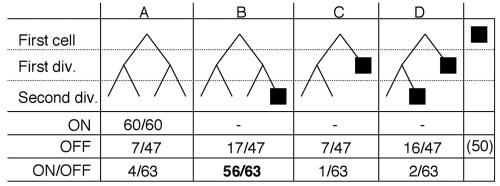FIG. 6.
Cellular MT pedigree analysis. Diploid cells from the strain containing mat1::nmt1/mat1-M smt-0 were separated by micromanipulation during at least three divisions (two divisions are shown, for simplicity) and observed microscopically for growth and spore formation on solid sporulation medium in the following three different growing conditions: transcription on, off, and on/off. The four possible pedigrees are shown (A, B, C, and D), in which B and D represent the one-in-four and consecutive switching rules, respectively. The filled-in squares represent cells that formed an ascus, indicating that mat1::nmt1 contained the P allele. Virgin M-containing diploid cells (mat1-M::nmt1/mat1-M smt-0) maintained in the on condition were unswitchable. The experimental switching efficiency, in which virgin M diploid cells were then placed in the off condition for micromanipulation, is in boldface type (56 of 63 cells) and indicates that 89% of the virgin mat1-M-containing chromatids are unswitchable and that no more than two divisions are required to switch to mat1P (Miyata's one-in-four switching rule).

